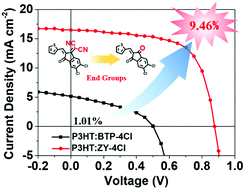Molecular design of a non-fullerene acceptor enables a P3HT-based organic solar cell with 9.46% efficiency†
Abstract
The advantage of low cost makes P3HT one of the most attractive electron donors for photovoltaic applications, but the power conversion efficiency (PCE) of the P3HT-based organic solar cells (OSCs) remains low (7–8%). Herein, to modulate the phase separation morphology so as to enhance the PCE in P3HT-based OSCs, a new NFA, namely ZY-4Cl, is designed and synthesized by modifying the cyano-substituted end groups in BTP-4Cl. The P3HT:ZY-4Cl based OSC exhibits a significantly improved PCE of ∼9.5%, which is a new record for the P3HT-based OSCs. Furthermore, two model compounds, TT-CN and TT-O, are synthesized to simulate the end groups of BTP-4Cl and ZY-4Cl, respectively. The calculated Flory-Huggins interaction parameter, the DSC and the AFM results clearly indicate that the cyano-substituted compound TT-CN shows much stronger miscibility with P3HT compared to TT-O, the one without cyano groups. This molecular design strategy is also verified in the other two representative NFAs. Therefore, this work not only reports an NFA with a high PCE for P3HT-based OSCs, but also suggests guidance for the molecular design of NFAs from the aspect of morphology control.



 Please wait while we load your content...
Please wait while we load your content...